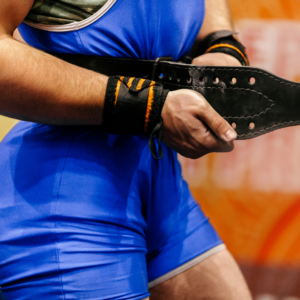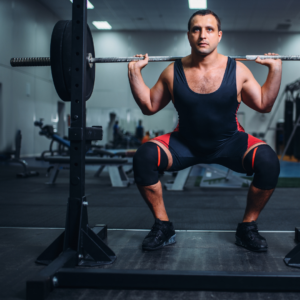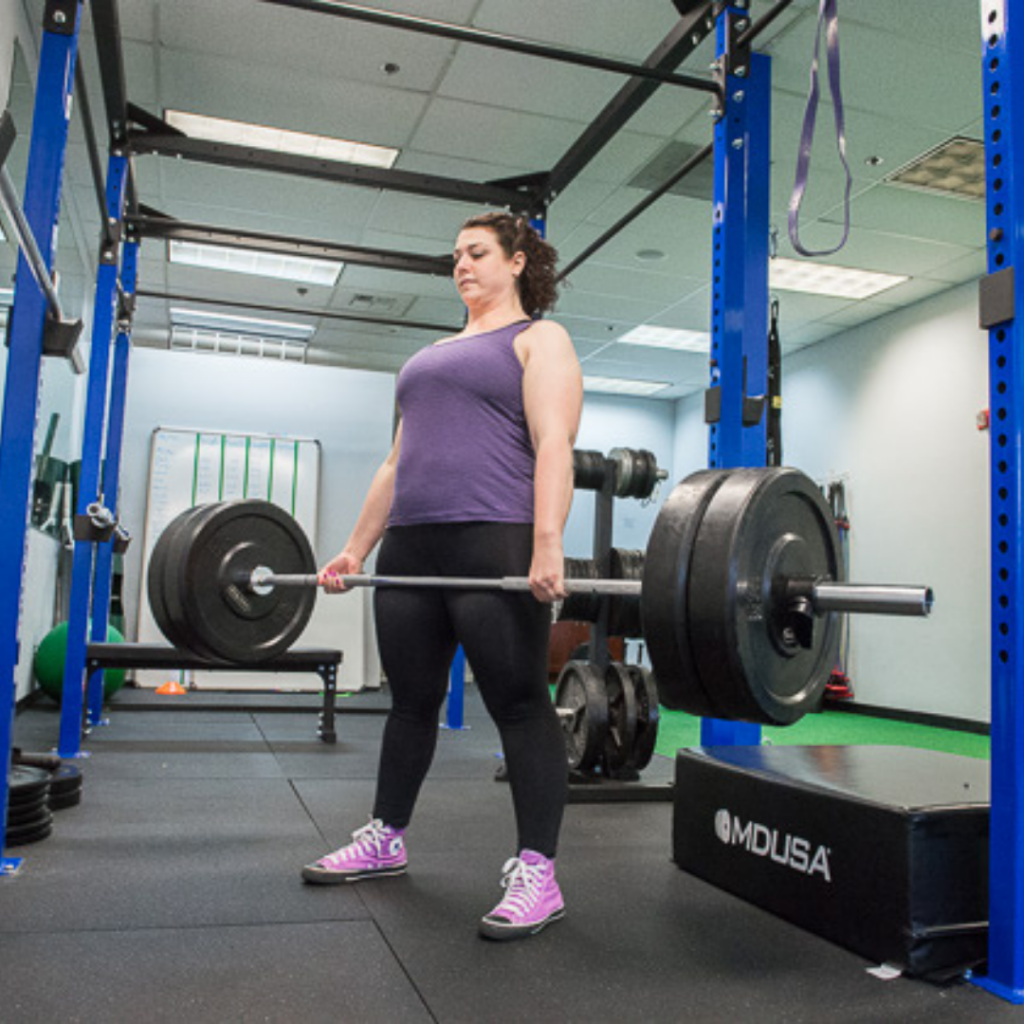If you’re new to strength training, working with free weights, and powerlifting you might have a few questions about the different types weight lifting gear used by other lifters in your gym. I’m going to give you the rundown on what each of the pieces of equipment are and when they should be used so you can get an idea of whether you need to implement the use of any weight lifting gear.

Table of Contents
ToggleWeight Lifting Belts
A weight lifting belt is usually the first piece of weight lifting gear that comes to mind when you think of what you need to start training with free weights. In actuality, a belt is not usually necessary for the novice lifter, or if you’re not planning on testing a one rep max on compound lifts (such as back squat, or deadlift).
Oftentimes I get questions about belts, and assumptions about its use in protecting your back while weight training. A weight lifting belt is not used to protect the back, but to give you something to brace against when working at a maximal effort. Did you know, we actually have our own built-in ‘belt’ that will do the job of stabilizing your back and creating positional strength in your weight training? …our abdominal muscles! Head over to another of my blogs where I talk about the exercises you should be focusing on to increase your core strength and stability.
If you start employing a weight lifting belt too early in your training, you’re actually going to increase your risk of injury, plus you’ll be doing your abs a disservice by not engaging them while you’re weight training.
Now that we have that out of the way, when do I recommend using a weight lifting belt in your training? What kind of weight lifting belt should you try, and how much does it cost to get your very own?
Progressive Performance focuses on general fitness clients, as well as powerlifting, so our programming follows a periodized progression (high reps at a low weight → low reps at a higher weight) over an approximate 16 week cycle. For our powerlifting-focused clients, we wait to bust out the belts until the lifters are working with 80{885586236f5820200058e61f9e2fcec1023d525f8b1a6e4e5a4fd7f3c0d65acb} of their 1RM (one rep max) for a particular compound lift/competition lift (squat/benchpress/deadlift), which usually happens around the 5 rep-range.
There are lots of different options of weight training belts available, and each have their own specific uses. Olympic weight lifting (clean & jerk/snatch) and crossfit-style training most often use a soft weight training belt, like this one from Rogue, made of velcro, nylon, foam, etc. that provides support but also the mobility required for those dynamic movements of their specific sports.
Powerlifters prefer a stiffer weight lifting belt made of many layers of leather, and have either a buckle or lever closure. Pioneer, Rogue, and Inzer are the big names in power belts. Due to the materials and structure of power belts, the price point is significantly higher than the soft belts, and you can even customize the design of your belt if you want to show off your personality!
Before shelling out a bunch of money to buy your own custom leather power belt, see if your gym, coach, personal trainer, (or gym friends) has a belt you can try out first. If you’re not planning to compete in powerlifting on a regular basis, it doesn’t make a ton of sense to purchase your own belt, especially if you’re not training to test one rep maxes in the competitive lifts. Weight lifting and power belts are the most expensive piece of weight lifting gear on this list, keep reading to see what else might be a better fit for your training!
Knee Sleeves – Not Just for Former Football Players with Bad Knees

Much like weight lifting belts, there are SO MANY different options available for knee sleeves, and depending on your training program, specific-sport, or injury history, there’s a pair of sleeves out there for you!
Knee sleeves are used to provide support and stability to the knees in the squat most of the time (but can be used while doing unilateral work like lunges/single-leg squat or single leg Romanian Deadlifts, as well as during barbell and trapbar deadlifts). Knee sleeves are produced with different thicknesses of the neoprene depending on how much support is needed, or like with powerlifting you want a bit of ‘bounce’ at the bottom of the squat.
For general fitness clients, I recommend utilizing knee sleeves if you’re experiencing chronic (and limiting) discomfort in the knees during squats, deadlifts, and/or unilateral lower body exercises. Sharp pain, or pain after a traumatic event, should be evaluated by a doctor to make sure that there isn’t damage to the knee on a muscular or skeletal level.
You can find a wide array of knee sleeves on Amazon, but be sure to follow the measurement guides so that you grab the right size for you! Slipping a tight knee sleeve over your pant-covered leg muscles can be a bit of a challenge, but there are tips and tricks to being successful.
Wrist Wraps
Wrist wraps are a piece of weight lifting gear that is highly specific, and used primarily for upper body exercises like barbell bench press, dumbbell press, overhead press, etc. to help support and stabilize the wrists. If you’ve got a previous injury to your wrist or hand, employing a wrist wrap to stabilize that joint may help you to feel more comfortable and confident while weight training.
Wrist wraps are also used by some lifters while squatting, both in the back squat and in the front rack position (front squats put significantly more stress on the wrist in this position). If you’re finding discomfort in your wrist and forearms (not including elbows), grabbing a pair of wrist wraps might just be the easy fix to make your weight training feel better! Also, probably the most inexpensive piece of weight lifting gear you can throw in your gym bag too!
Once again, Amazon has a wide range of wrist wraps available, but if you’re a powerlifter looking to compete, you’ll want to find wrist wraps that are allowed by and described in the rulebook of your federation. If you want minimal support, then look for a shorter length of wrist wrap, or if you’re planning to max out your bench press then you may want a longer wrist wrap (more layers wrapped around your wrist = more support).
Elbow Sleeves
Elbow sleeves are a niche piece of weight lifting gear, but the idea behind them is very similar to knee sleeves. Elbow sleeves help to support and stabilize the elbows during pressing exercises like barbell bench press, dumbbell press, overhead press, etc., however not often used by many lifters in a mainstream gym, or in a general fitness program. Powerlifters are most likely to employ elbow sleeves when training to increase their bench press max weight.
If you’re finding discomfort in the elbows during pressing movements, the first recommendation would be to back off those exercises for a bit until the inflammation caused by overuse calms down. If you’re experiencing chronic pain/discomfort, have the joint evaluated by a doctor. If your doctor recommends a sleeve, then talk to your coach or trainer about purchasing that piece of weight lifting gear.
Equipped Lifting: Bench Shirts, Squat Briefs, and Deadlift Suits
Even more niche than elbow sleeves, the world of equipped or geared powerlifting. Powerlifters looking to push (see what I did there…????) their limits in the competitive lifts will add tight equipment (i.e. bench shirts, or squat suits) to give them the extra bounce needed to move additional weight beyond what their body naturally (with the aid of a power belt and knee sleeves) would be able to do. You probably don’t need to worry about these pieces of weight lifting gear if you’re a novice lifter, general fitness athlete, or never planning to compete in powerlifting.
Want to learn more about equipped powerlifting? Check out this article from Barbend on the difference between Raw and Equipped Lifting.
Conclusion: What Do You Actually Need to Weight Train
When it comes to weight lifting and improving your fitness, what you truly need to be successful is quite simple. Athletic clothing that allows you to move comfortably, like shorts, tank tops, yoga pants, tee shirts, etc. Shoes are also important, especially for weight training! Flat soled shoes are preferred (compared to squishy running shoes) like Converse, No Bull, Keds, etc. so that you can maintain nice contact with the floor and stability for the entire leg.
If you’re ready to start weight training, our coaches are ready to help you reach your goals (no fancy accessories needed)! What can you accomplish when you Jumpstart your Fitness?

Let’s get started today – we can’t wait to meet you! Email Jimmy ([email protected]) to schedule your movement and goal setting meeting today, a complimentary 60 minute session with one of our coaching staff.



